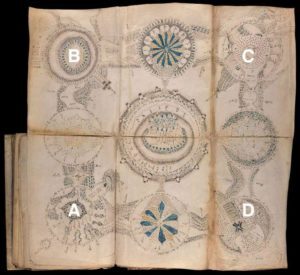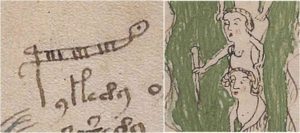
UNIVERSITY OF BRISTOL—A University of Bristol academic has succeeded where countless cryptographers, linguistics scholars and computer programs have failed – by cracking the code of the ‘world’s most mysterious text’, the Voynich manuscript.
Although the purpose and meaning of the manuscript had eluded scholars for over a century, it took Research Associate Dr. Gerard Cheshire two weeks, using a combination of lateral thinking and ingenuity, to identify the language and writing system of the famously inscrutable document.
In his peer-reviewed paper, The Language and Writing System of MS408 (Voynich) Explained, published in the journal Romance Studies, Cheshire describes how he successfully deciphered the manuscript’s codex and, at the same time, revealed the only known example of proto-Romance language.
“I experienced a series of ‘eureka’ moments whilst deciphering the code, followed by a sense of disbelief and excitement when I realized the magnitude of the achievement, both in terms of its linguistic importance and the revelations about the origin and content of the manuscript.
“What it reveals is even more amazing than the myths and fantasies it has generated. For example, the manuscript was compiled by Dominican nuns as a source of reference for Maria of Castile, Queen of Aragon, who happens to have been great aunt to Catherine of Aragon.
“It is also no exaggeration to say this work represents one of the most important developments to date in Romance linguistics. The manuscript is written in proto-Romance – ancestral to today’s Romance languages including Portuguese, Spanish, French, Italian, Romanian, Catalan and Galician. The language used was ubiquitous in the Mediterranean during the Medieval period, but it was seldom written in official or important documents because Latin was the language of royalty, church and government. As a result, proto-Romance was lost from the record, until now.”
Cheshire explains in linguistic terms what makes the manuscript so unusual:
“It uses an extinct language. Its alphabet is a combination of unfamiliar and more familiar symbols. It includes no dedicated punctuation marks, although some letters have symbol variants to indicate punctuation or phonetic accents. All of the letters are in lower case and there are no double consonants. It includes diphthong, triphthongs, quadriphthongs and even quintiphthongs for the abbreviation of phonetic components. It also includes some words and abbreviations in Latin.”
The next step is to use this knowledge to translate the entire manuscript and compile a lexicon, which Cheshire acknowledges will take some time and funding, as it comprises more than 200 pages.
“Now [that] the language and writing system have been explained, the pages of the manuscript have been laid open for scholars to explore and reveal, for the first time, its true linguistic and informative content.”
The Voynich manuscript is a medieval, handwritten and illustrated text, which has been carbon-dated to the mid-fifteenth century. It is named after Wilfrid M. Voynich (1865-1930), a Polish book dealer and antiquarian, who purchased the manuscript in 1912. This happens to be the same year that its place of origin, Castello Aragonese, Ischia, fell into private ownership, so it seems likely that the manuscript was part of the ‘house clearance’ prior to the property sale. It is currently housed at Yale University, where it is filed as item MS408 in the Beinecke Library of rare books and manuscripts. Given its cultural importance, there would seem to be legitimate call for its safe return to the Italian people in due course.
The manuscript was first revealed to the public in 1915 and its intriguing illustrations and unknown script immediately captured the imaginations of scholars the world over. Among those who have famously attempted to crack the code are Alan Turing and colleagues at Bletchley Park. The FBI also had a go during the Cold War, apparently thinking it may have been Communist propaganda!
Translations so far have revealed the manuscript is a compendium of herbal remedies, therapeutic bathing and astrological readings concerning matters of the female mind and body, of reproduction and parenting, and the heart, in accordance with the Catholic and Roman pagan religious beliefs of Mediterranean Europeans during the late Medieval period.
There is a fascinating pictorial map within the manuscript. It tells the remarkable tale of a rescue mission by ship, led by Queen Maria, to save the survivors of a volcanic eruption close to the island of Vulcano, which began 4th February 1444. The map, which shows Ischia, Castello Aragonese, Lipari, Vulcano and Vulcanello, enabled the manuscript’s exact location and date of origin to be ascertained.
There is some irony in realizing that the manuscript was not written in code at all, but a contemporaneous language and writing system that fell out of use. The writing system is more singular and less intuitive than modern systems, which may be why it ultimately became obsolete. However, a significant vestige of the language has survived, with its lexicon sequestered into the many modern languages of Mediterranean Europe.
______________________________

Vignette A illustrates the erupting volcano that prompted the rescue mission and the drawing of the map. It rose from the seabed to create a new island given the name Vulcanello, which later became joined to the island of Vulcano following another eruption in 1550. Vignette B depicts the volcano of Ischia, vignette C shows the islet of Castello Aragonese, and vignette D represents the island of Lipari. Each vignette includes a combination of naïvely drawn and somewhat stylized images along with annotations to explain and add detail. The other five vignettes describe further details of the story. Voynich manuscript
______________________________

This shows the word ‘palina’ which is a rod for measuring the depth of water, sometimes called a stadia rod or ruler. The letter ‘p’ has been extended. Voynich manuscript
______________________________

This shows two women dealing with five children in a bath. The words describe different temperaments: tozosr (buzzing: too noisy), orla la (on the edge: losing patience), tolora (silly/foolish), noror (cloudy: dull/sad), or aus (golden bird: well behaved), oleios (oiled: slippery). These words survive in Catalan [tozos], Portuguese [orla], Portuguese [tolos], Romanian [noros], Catalan [or aus] and Portuguese [oleio]. The words orla la describe the mood of the woman on the left and may well be the root of the French phrase ‘oh là là’, which has a very similar sentiment. Voynich manuscript
Article Source: University of Bristol news release
*The Language and Writing System of MS408 (Voynich) Explained
Author: Gerard Cheshire https:/




